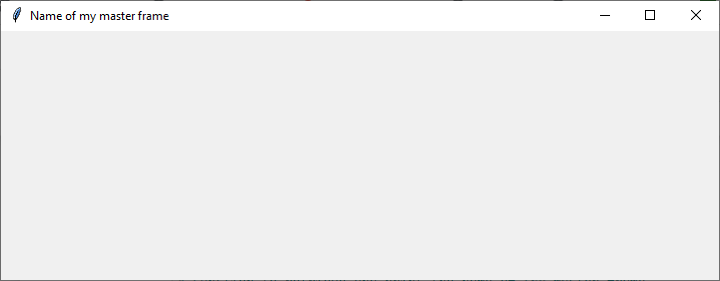
 Data Structure
Data Structure Networking
Networking RDBMS
RDBMS Operating System
Operating System Java
Java MS Excel
MS Excel iOS
iOS HTML
HTML CSS
CSS Android
Android Python
Python C Programming
C Programming C++
C++ C#
C# MongoDB
MongoDB MySQL
MySQL Javascript
Javascript PHP
PHP
- Selected Reading
- UPSC IAS Exams Notes
- Developer's Best Practices
- Questions and Answers
- Effective Resume Writing
- HR Interview Questions
- Computer Glossary
- Who is Who
How to get the name of the Master Frame in Tkinter?
Tkinter is a popular Python library used for creating graphical user interfaces (GUIs). It provides a wide range of widgets and functionalities to build interactive applications. When developing complex GUIs with Tkinter, it is crucial to have access to various attributes and properties of the GUI elements.
In this article, we will explore how to obtain the name of the master frame in Tkinter, which can be useful for programmatic manipulation of the GUI structure.
Understanding Tkinter Frames
In Tkinter, a frame is a rectangular area used to organize and group other widgets. It serves as a container for holding other GUI elements and provides a way to organize the layout of the interface. Each frame can have a unique name assigned to it, allowing for easy identification and manipulation.
Accessing the Name of the Master Frame
To access the name of the master frame in Tkinter, we can make use of the title() method available on the root window. Since the master frame is typically the root window, we can retrieve its name using this method. Let's explore the implementation details.
Python Implementation
First, let's start by importing the required modules and creating a basic Tkinter application with a master frame
# Import necessary libraries
import tkinter as tk
# Create an instance of Tkinter Frame
root = tk.Tk()
# Set the geometry of Tkinter Frame
root.geometry("720x250")
# Set the title of Tkinter Frame
root.title("Name of my master frame")
# Create a master frame
master_frame = tk.Frame(root, name="master_frame")
master_frame.pack()
# Run the Tkinter event loop
root.mainloop()
In the above code, we import the tkinter module and create an instance of Tk, which represents the main window of the application. We set the title of the window to "My Application" for illustrative purposes. Next, we create a Frame widget called master_frame as a child of the root window. We assign the name "master_frame" to this frame using the name parameter, which allows us to access it later. Finally, we start the Tkinter event loop with root.mainloop().
Now, let's implement a function that retrieves and prints the name of the master frame
def get_master_frame_name():
# Get the name of the master frame (root window)
frame_name = root.title()
# Print the name of the master frame
print("Master Frame Name:", frame_name)
In this function, we retrieve the name of the master frame by calling root.title(). This method returns the title of the root window, which we consider as the name of the master frame in this context. Finally, we print the name of the master frame using the print() function.
To call the get_master_frame_name() function and observe the output, we can modify our code as follows
Example
# Import necessary libraries
import tkinter as tk
# Create an instance of Tkinter Frame
root = tk.Tk()
# Set the geometry of Tkinter Frame
root.geometry("720x250")
# Set the title of Tkinter Frame
root.title("Name of my master frame")
# Create a master frame
master_frame = tk.Frame(root, name="master_frame")
master_frame.pack()
# Function to retrieve and print the name of the master frame
def get_master_frame_name():
frame_name = root.title()
print("Master Frame Name:", frame_name)
# Call the function
get_master_frame_name()
# Run the Tkinter event loop
root.mainloop()
Output
After running the code, the output should display the name of the master frame as "Name of my master frame" or any other name provided as the title of the root window.

Master Frame Name: Name of my master frame
Conclusion
In conclusion, obtaining the name of the master frame in Tkinter can be accomplished by using the title() method on the root window. By retrieving the title, which serves as the name of the master frame in this context, we can access and manipulate the GUI structure programmatically. This capability is particularly useful when working with complex Tkinter applications that involve multiple frames and widgets.
By leveraging the ability to retrieve the name of the master frame, developers can dynamically customize the behavior, layout, or content of specific frames based on their names. This flexibility allows for more interactive and responsive GUIs.
Understanding how to access the master frame's name empowers developers to create modular and scalable Tkinter applications. It facilitates efficient organization and management of widgets, as well as enables targeted updates and modifications.
By incorporating this knowledge into your Tkinter projects, you can take full advantage of the library's capabilities and build powerful, user-friendly graphical interfaces tailored to your specific needs.

